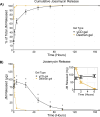γ-Cyclodextrin hydrogel for the sustained release of josamycin for potential ocular application
- PMID: 38899440
- PMCID: PMC11191840
- DOI: 10.1080/10717544.2024.2361168
γ-Cyclodextrin hydrogel for the sustained release of josamycin for potential ocular application
Abstract
Glaucoma is the leading cause of blindness worldwide. However, its surgical treatment, in particular via trabeculectomy, can be complicated by fibrosis. In current clinical practice, application of the drug, Mitomycin C, prevents or delays fibrosis, but can lead to additional side effects, such as bleb leakage and hypotony. Previous in silico drug screening and in vitro testing has identified the known antibiotic, josamycin, as a possible alternative antifibrotic medication with potentially fewer side effects. However, a suitable ocular delivery mechanism for the hydrophobic drug to the surgical site does not yet exist. Therefore, the focus of this paper is the development of an implantable drug delivery system for sustained delivery of josamycin after glaucoma surgery based on crosslinked γ-cyclodextrin. γ-Cyclodextrin is a commonly used solubilizer which was shown to complex with josamycin, drastically increasing the drug's solubility in aqueous solutions. A simple γ-cyclodextrin crosslinking method produced biocompatible hydrogels well-suited for implantation. The crosslinked γ - cyclodextrin retained the ability to form complexes with josamycin, resulting in a 4-fold higher drug loading efficiency when compared to linear dextran hydrogels, and prolonged drug release over 4 days.
Keywords: drug delivery; fibrosis; glaucoma; hydrogel; josamycin; γ-cyclodextrin.
Conflict of interest statement
J.H., T.E, S.O., N.G., K.S., T.S., O.S., A.J., G.F. are listed as inventors on related pending patents submitted on behalf of the Rostock University Medical Center. The authors declare no other competing financial interests or personal relationships that could have appeared to influence the work reported in this paper.
Figures






Similar articles
-
Physically crosslinked chitosan/αβ-glycerophosphate hydrogels enhanced by surface-modified cyclodextrin: An efficient strategy for controlled drug release.Int J Biol Macromol. 2024 Dec;283(Pt 1):137163. doi: 10.1016/j.ijbiomac.2024.137163. Epub 2024 Nov 5. Int J Biol Macromol. 2024. PMID: 39510462
-
Cyclodextrin controlled release of poorly water-soluble drugs from hydrogels.Drug Deliv. 2008 Jan;15(1):69-80. doi: 10.1080/10717540701829267. Drug Deliv. 2008. PMID: 18197526
-
Potential use of gamma-cyclodextrin polypseudorotaxane hydrogels as an injectable sustained release system for insulin.Int J Pharm. 2010 Jun 15;392(1-2):83-91. doi: 10.1016/j.ijpharm.2010.03.026. Epub 2010 Mar 16. Int J Pharm. 2010. PMID: 20298768
-
Development of hyaluronic acid/β-cyclodextrin semi-interpenetrating network hydrogels for prolonged delivery of water-soluble sunitinib malate.Int J Pharm. 2025 Jan 25;669:125039. doi: 10.1016/j.ijpharm.2024.125039. Epub 2024 Dec 9. Int J Pharm. 2025. PMID: 39662858
-
The ascension of nanosponges as a drug delivery carrier: preparation, characterization, and applications.J Mater Sci Mater Med. 2022 Mar 4;33(3):28. doi: 10.1007/s10856-022-06652-9. J Mater Sci Mater Med. 2022. PMID: 35244808 Free PMC article. Review.
Cited by
-
Advancements in Wearable and Implantable BioMEMS Devices: Transforming Healthcare Through Technology.Micromachines (Basel). 2025 Apr 28;16(5):522. doi: 10.3390/mi16050522. Micromachines (Basel). 2025. PMID: 40428648 Free PMC article. Review.
-
Cyclodextrin-Hydrogel Hybrids in Advanced Drug Delivery.Gels. 2025 Feb 28;11(3):177. doi: 10.3390/gels11030177. Gels. 2025. PMID: 40136882 Free PMC article. Review.
References
-
- Antlsperger G, Schmid G. (1996). Toxicological comparison of cyclodextrins. In Proceedings of the eighth international symposium on cyclodextrins. Dordrecht: Springer, 149–55. doi: 10.1007/978-94-011-5448-2_32. - DOI
-
- Bodelier VMW, van Haeringen NJ, Klaver PSY. (1993). Species differences in tears; Comparative investigation in the chimpanzee (Pan troglodytes). Primates 34:77–84. doi: 10.1007/BF02381283. - DOI
MeSH terms
Substances
LinkOut - more resources
Full Text Sources
Other Literature Sources
